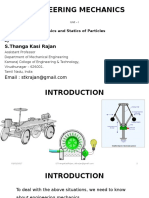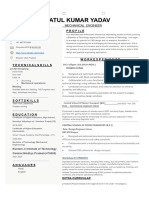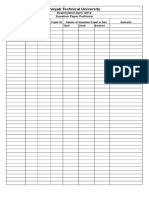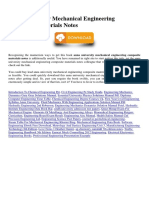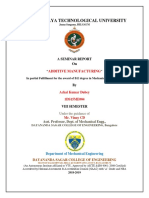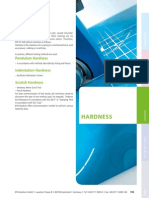Engineering Mechanics
Uploaded by
Rishika ReddyEngineering Mechanics
Uploaded by
Rishika ReddyENGINEERING MECHANICS
L T P M 4 0 0 100 UNIT I STATICS OF PARTICLES (10)
Units and Dimensions Law of Mechanics Vectorial representation forces and moments - Vector Operation - Addition, subtraction, dot product, cross product Concepts of Particles and Rigid bodies Composition of concurrent forces in Plane Free body Diagram Equilibrium of Rigid bodies in Two dimensions. UNIT II PROPERTIES OF SURFACES, MOMENTS AND PRODUCTS OF INERTIA (12) Determination of Areas First moment of area Centroid of sections Rectangle, Circle, Triangle, T section, I section, Angle section, Hollow section Second and Product moments of Plane area Rectangle, Triangle, Circle, T section, I section, Angle section, Hollow section Parallel axis theorem - Perpendicular axis theorem Polar Moment of Inertia. UNIT III FRICTION (7)
Laws of coulomb Friction Coefficient of Friction Dry Friction Sliding Friction Ladder friction Belt friction V-Belt Screw Jack Rolling Resistance. UNIT IV KINEMATICS OF PARTICLES (10)
Introduction Velocity and Acceleration Rectangular Components Kinematical Relations and Applications Newtons Law Rectilinear Translation Curvilinear motion Components of motion Projectile motion. UNIT V WORK ENERGY METHODS, IMPULSE AND MOMENTUM (9)
Work Energy Method Conservation of Energy Impulse and Momentum Relation Impulsive Forces Impact force Conservation of momentum Moment of Momentum Equation. Total = 48 TEXT BOOKS 1. Irving H. Shames and G.Krishna Mohana Rao, Engineering Mechanics Statics and Dynamics, 4th Edition, Pearson Education, 2006. 2. M.V Seshagiri Rao and D Rama Durgaiah, Engineering Mechanics, University Press, 2005. REFERENCES 1. Beer F.P and Johnson E.R., Vector Mechnics for Engineers Statics and Dynamics, Tata McGraw-Hill Publishing Compony Ltd., New Delhi, 2001. 2. K.V.Natarajan, Engineering Mechanics, Dhanalakshmi Publishers, Chennai, 2006.
You might also like
- Chapter 22: Principles of Passive Vibration Control: BasicsNo ratings yetChapter 22: Principles of Passive Vibration Control: Basics11 pages
- Module 5 Balancing of Rotating Masses NM RepairedNo ratings yetModule 5 Balancing of Rotating Masses NM Repaired25 pages
- Unit 1 - Two Mark Questions With Answers Oct 23No ratings yetUnit 1 - Two Mark Questions With Answers Oct 234 pages
- GE6253 Engineering Mechanics 2 Mark With Answers R2013100% (2)GE6253 Engineering Mechanics 2 Mark With Answers R201313 pages
- Engineering Mechanics: S.Thanga Kasi RajanNo ratings yetEngineering Mechanics: S.Thanga Kasi Rajan57 pages
- 11 Cutting Temperature - Causes, Effects, Assessment100% (3)11 Cutting Temperature - Causes, Effects, Assessment14 pages
- Introduction To Structures & MechanismsNo ratings yetIntroduction To Structures & Mechanisms55 pages
- Thermal Engineering-II Course Code: 4351903No ratings yetThermal Engineering-II Course Code: 435190312 pages
- Assignment Question Set On Modern Manufacturing ProcessNo ratings yetAssignment Question Set On Modern Manufacturing Process1 page
- Me3351 Engineering Mechanics - Question BankNo ratings yetMe3351 Engineering Mechanics - Question Bank20 pages
- Unit 1. Fundamentals of Design Master b5No ratings yetUnit 1. Fundamentals of Design Master b520 pages
- Design of Machine Elements Hand Written Notes PDFNo ratings yetDesign of Machine Elements Hand Written Notes PDF17 pages
- COMPUTER AIDED MACHINE DRAWING Lab Manual-2017 - 1 PDF0% (1)COMPUTER AIDED MACHINE DRAWING Lab Manual-2017 - 1 PDF54 pages
- Balancing: Submitted By: Kanwaldeep SinghNo ratings yetBalancing: Submitted By: Kanwaldeep Singh23 pages
- Experiment-3 Balancing of Multiple Mass in Single PlaneNo ratings yetExperiment-3 Balancing of Multiple Mass in Single Plane5 pages
- ME G511 Lect 25 Equation of Motion Nov 2018No ratings yetME G511 Lect 25 Equation of Motion Nov 201823 pages
- Amandeep Singh Bansal - Mechanical Vibration 2 Marks Questions With Answer100% (1)Amandeep Singh Bansal - Mechanical Vibration 2 Marks Questions With Answer5 pages
- 01.class 01 Introduction To Dynamic of MachineryNo ratings yet01.class 01 Introduction To Dynamic of Machinery25 pages
- Mechanical Engineering Paper 01 Detailed SolutionNo ratings yetMechanical Engineering Paper 01 Detailed Solution46 pages
- Advances in Manufacturing & Industry 4.0No ratings yetAdvances in Manufacturing & Industry 4.02 pages
- Anna University Mechanical Engineering Composite Materials NotesNo ratings yetAnna University Mechanical Engineering Composite Materials Notes1 page
- GE8152 Engineering Graphics - Course Materials PDFNo ratings yetGE8152 Engineering Graphics - Course Materials PDF110 pages
- National Institute of Technology, Rourkela B. Tech. (6 Semester), Mechanical Engineering, Mid-Semester, Spring (2021-22)No ratings yetNational Institute of Technology, Rourkela B. Tech. (6 Semester), Mechanical Engineering, Mid-Semester, Spring (2021-22)9 pages
- ED4111 Cad and Design For Manufacture and Assembly LabNo ratings yetED4111 Cad and Design For Manufacture and Assembly Lab68 pages
- Degree: B.E. Regulation: 2008 Branch: Mechanical Engineering Semester: 05 Duration: 3 Hours Max. Marks: 100No ratings yetDegree: B.E. Regulation: 2008 Branch: Mechanical Engineering Semester: 05 Duration: 3 Hours Max. Marks: 10048 pages
- Engineering Mechanics 2 Marks and 11 Marks100% (1)Engineering Mechanics 2 Marks and 11 Marks89 pages
- Ge6253 Engineering Mechanics L T P c3 1 0 4No ratings yetGe6253 Engineering Mechanics L T P c3 1 0 41 page
- Unravelling Food Basket of Indian Households: Revisiting Underlying Changes and Future Food DemandNo ratings yetUnravelling Food Basket of Indian Households: Revisiting Underlying Changes and Future Food Demand17 pages
- Zoeteman2010 Article HandlingWEEEWasteFlowsOnTheEff PDFNo ratings yetZoeteman2010 Article HandlingWEEEWasteFlowsOnTheEff PDF22 pages
- Account Statement From 1 Apr 2019 To 31 Mar 2020: TXN Date Value Date Description Ref No./Cheque No. Debit Credit BalanceNo ratings yetAccount Statement From 1 Apr 2019 To 31 Mar 2020: TXN Date Value Date Description Ref No./Cheque No. Debit Credit Balance2 pages
- Saathi Pads: Disrupting The Feminine Hygiene Sector With An Eco-Friendly, Natural, and Safe AlternativeNo ratings yetSaathi Pads: Disrupting The Feminine Hygiene Sector With An Eco-Friendly, Natural, and Safe Alternative16 pages
- Applied Sciences: E-Waste Reverse Supply Chain: A Review and Future PerspectivesNo ratings yetApplied Sciences: E-Waste Reverse Supply Chain: A Review and Future Perspectives28 pages
- Consumption, Technology and Adaptation: Care and Repair Economies of Mobile Phones in North IndiaNo ratings yetConsumption, Technology and Adaptation: Care and Repair Economies of Mobile Phones in North India23 pages
- E-Waste Management POLICY 2017: Information Technology, Electronics & Communications Department, Government of TelanganaNo ratings yetE-Waste Management POLICY 2017: Information Technology, Electronics & Communications Department, Government of Telangana11 pages
- Decision Factors in N-Mexico - To Waste or TradeNo ratings yetDecision Factors in N-Mexico - To Waste or Trade14 pages
- Operating System and Memory: Presentation OnNo ratings yetOperating System and Memory: Presentation On31 pages
- Powerone, Power Supply 48V Rectifier Module (Aspiro XR08.48)No ratings yetPowerone, Power Supply 48V Rectifier Module (Aspiro XR08.48)3 pages
- Compellent Storage Center (Advanced Administration) Training Guide - IntroNo ratings yetCompellent Storage Center (Advanced Administration) Training Guide - Intro12 pages
- Qorvo 5g Wireless Infrastructure Brochure PDFNo ratings yetQorvo 5g Wireless Infrastructure Brochure PDF4 pages
- Handwritten Javanese Script Recognition Method Based 12-Layers Deep Convolutional Neural Network and Data AugmentationNo ratings yetHandwritten Javanese Script Recognition Method Based 12-Layers Deep Convolutional Neural Network and Data Augmentation11 pages








